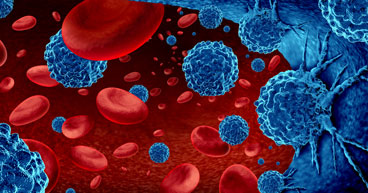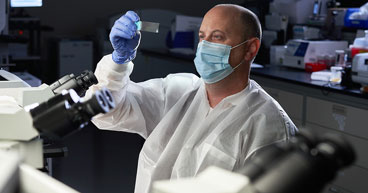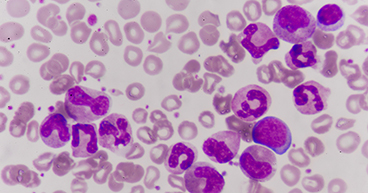
A runny nose, a persistent cough or a fever are signs that the immune system is fighting infection. With cancer, some signs and symptoms are common to most every cancer type—like fatigue or unexplained weight loss—but some symptoms are specific to certain cancer types. For example, seizures, chronic headaches and/or vision and balance problems are often linked with brain cancer. Bloody coughs, hoarseness and/or a persistent cough are among the most common signs of lung cancer.
When it comes to leukemia, many patients notice changes to the skin—they may bruise easily and sometimes develop red spots or a rash. In this article, we’ll take explain bruising, rashes and other skin changes that may be caused by leukemia.
Topics include:
- What is leukemia?
- What does petechiae look like?
- Why do leukemia patients bruise easily?
- What is leukemia cutis?
- Leukemia care at City of Hope
If you’ve been diagnosed with leukemia or another blood cancer, such as lymphoma or multiple myeloma, and are interested in a second opinion about your diagnosis or treatment options, call us or chat online with a member of our team.
What is leukemia?
Human blood is made from three main types of cells:
- White blood cells help bolster the immune system.
- Red blood cells carry oxygen from the lungs to the rest of the body.
- Platelets help the blood to clot.
Leukemia is a type of blood cancer that develops when blood cells—most often white blood cells—undergo abnormal changes, or mutations. When abnormal blood cells begin to grow out of control, they may eventually crowd out the healthy red and white blood cells and platelets.
Leukemia cells disrupt the healthy development of all three types of blood cells, weakening the body’s ability to fight infection, carry oxygen, and properly clot blood. The rapid growth and spread of abnormal cells, combined with a scarcity of healthy ones, may result in a variety of symptoms. Common symptoms of leukemia include:
- Fatigue
- Fever and chills
- Bone pain
- Shortness of breath
- Frequent infections
- Skin rash
- Weight loss
- Nose bleeds
Unlike other types of cancer, leukemia and other blood cancers may not appear as a solid tumor visible on imaging tests. Rather, blood and bone marrow tests may be conducted to detect the presence of cancer cells in the blood. Imaging tests such as magnetic resonance imaging (MRI) and computerized tomography (CT) and positron emission tomography (PET) scans may be able to determine if the cancer has spread, to other parts of the body.
According to the National Cancer Institute, 60,650 cases of leukemia were diagnosed in the United States in 2022.
What does petechiae look like?
According to the medical journal BMJ Best Practice, petechiae is among the known common signs of leukemia. Leukemia-related petechiae occurs when tiny blood vessels called capillaries bleed beneath the skin, causing a rash with pinprick-sized red, brown or purple spots on the skin, usually the arms and legs. In a healthy person, platelets (or thrombocytes) help the blood to clot, preventing abnormal bleeding. Since leukemia may lower platelet counts, blood escapes from capillaries, settling at the skin’s surface and appearing as petechiae.
It’s important to note that a variety of noncancerous conditions such as viral, fungal or bacterial infections, such as strep throat, sepsis or even an adverse reaction to medication, may also cause petechiae.
Though it’s most commonly found on the arms and legs, a petechiae leukemia rash may also appear on the buttocks, the inside of the mouth or the eyelids. Though it looks like a rash of pinhead-sized spots, petechiae is actually a cluster of tiny bruises.
Why do leukemia patients bruise easily?
For the same reason petechiae form, easy bruising also is common in leukemia patients. People with leukemia bruise more easily because their bodies don't produce enough platelets to clot bleeding blood vessels. The medical term for too few platelets is thrombocytopenia, which is diagnosed when someone has fewer than 150,000 platelets per microliter of blood. A normal platelet count ranges from 150,000 platelets to 300,000.
Certain cancer treatments may also result in petechiae or large bruises. Leukemia patients and others with a low platelet count should take extra precautions to reduce their risk of bleeding and bruising, including:
- Being extra careful when using a knife, scissors or other sharp objects
- Avoiding contact sports and other physical activity that could result in an injury
- Brushing teeth with a soft toothbrush to avoid irritating the gums
- Asking a dentist whether flossing is safe
- Protecting the skin against scrapes and sharp objects
- Not going barefoot, even at home, to avoid an accidental cut or scrape
- Consulting a doctor about the use of ibuprofen, aspirin or other over-the-counter medicines that may increase bleeding risk
- Avoiding straining during a bowel movement
What is leukemia cutis?
A leukemia rash called leukemia cutis typically appears as bumpy or rubbery, flesh-colored, red or purple nodules on the legs, arms, back, chest, scalp or face.
Leukemia cutis is caused by the disease, appearing when white blood cells grow out of control and begin to invade the skin. The health care education journal StatPearls reports that leukemia cutis is much more common in children with congenital leukemia. In adults, leukemia cutis is most often associated with more aggressive leukemia and may indicate advanced acute lymphocytic leukemia. This rare type of rash is typically indicative of advanced disease.
Leukemia care at City of Hope
At City of Hope®, we treat leukemia with standard-of-care and evidence-based treatments and technology, while also helping patients maintain their quality of life with an integrative, whole-person approach to care. Common treatments for leukemia include:
- Chemotherapy
- Stem cell transplants
- Targeted therapy
- Immunotherapy
- Chimeric antigen receptor T-cell therapy
- Radiation therapy
At City of Hope, you have access to a team of physicians and clinicians who will tailor treatments to your specific needs, while also collaborating with supportive care providers to deliver evidence-informed services designed to address the symptoms of your disease and the side effects of treatment.
Supportive care services for leukemia patients at City of Hope may include:
Integrative care at City of Hope is a about keeping you strong so you can better tolerate your treatments without interruption and maintain your quality of life.
If you’ve been diagnosed with leukemia or another blood cancer, such as lymphoma or multiple myeloma, and are interested in a second opinion about your diagnosis or treatment options, call us or chat online with a member of our team.



